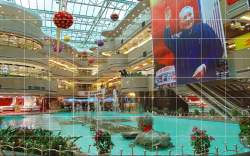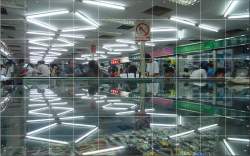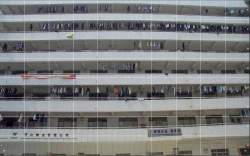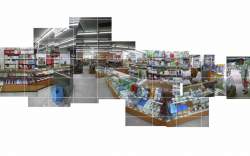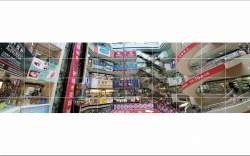Consumurbation
CHINESE ECONOMICS OF URBANISM
consumerization, clustering, dependencies, dormitories
by: Austin Kilroy
改革开放以来,中国的城市已经从共产主义工业化向商品社会转化,在这个商品社会里,消费和服务是至高无上的,国家的经济在迅猛发展。进出口贸易,金融,投资,等等项目,不断地增长着。中国制造的商品可以在世界上任何一个角落找到。带动整个国家发展的是城市。可以说所有的发展都是以城市为中心的;进入城市成为了广大国民对高生活水平追求的主要方式。而城市发展的模式恰恰就是市场经济。人们的消费水平随着收入的增加也随之提高。中国每年的国民消费额都以每年超过11%的速度增长着。降低利率、建造消费场所等等,政府的种种举措,无不是在促进消费。城市和消费之间是怎样的关系呢?简单地想一个问题:是城市化进程提高了消费还是消费水平的提高促进了城市化进程呢?城市的发展在不断满足人们消费的需求,还是人们的消费满足了城市的发展呢?
Feeding the machine
The transformation of urban China from industrial communism into conspicuous consumerism isn’t happening by accident. China wants to “balance” its legendary 9% annual economic growth 1 — currently generated by exports and investment 2— through increasing domestic consumer spending. 3 It also needs to soak-up 100–150 million rural workers 4 who are being rendered surplus by the closure of inefficient state-owned enterprises (SOEs*) plus improvements to manufacturing processes and market reforms in agriculture. 5 In tangible terms, Chinese clothes, bags, watches, electronics — already omnipresent in the global marketplace, from Moldova to Mozambique — need to be consumed more in China itself.
Cities will be the epicenters of this consumerist boom. Their efficacy as economic machines (generating higher incomes from which to consume 5), sites of socio-cultural change (individualism expressed through consumption of fashion, media and technology), and deterministic mechanisms (people need to consume more simply to subsist in urban environments 7), are the ingredients needed to make it happen. City-living engenders the money and desire for consumerization — supercharging the economic treadmill: “to each over and above his needs.” And this social reality is also reflected in the government’s economic agenda: China’s economic future rests on transforming cities from industrial bases into exactly the sites of bourgeois consumption that Mao decried. This is the Consumurbation* of China.
China’s economic future rests on transforming cities from industrial bases into exactly the sites of bourgeois consumption that Mao decried.
中国经济的未来存在于从工业基地向资产阶级消费区转变的城市中,而这些城市正式毛泽东曾经批评过的。
To see Consumurbation* in action, I flew to Chongqing. 1,500km inland from China’s coastal boomtowns, my plane passed over lush tropical vegetation and terraced rich paddies. Stepping off the plane, being enveloped by hot air and shrouded in yellow mist, this was far enough up the Yangtze River to feel like a Chinese version of Heart of Darkness. But here was a metropolis of 5.1 million people — bigger than Johannesburg, Sydney or Athens — sporting freeways and flyovers in physical contortions crazier even than Monaco. Skyscrapers tower over the riverbed, beside which a monorail system whisks the famously beautiful population from the “High and New Technology Development Zone” to department stores in the centre. Part of the city’s growing prosperity stems from the Western Development strategy, which aims to lessen regional inequalities across China and create “growth poles” in the west of the country (more about this later). The policy hopes to nudge the economic treadmill into life; mass consumption in Chongqing will then keep it going. Consumers in Chongqing are indeed spending a greater proportion of their income: in 2004 income grew by 12.2%, while consumer spending increased by 14.3% 8 — multiplying the injections of development money by reverberating it around the economy. 9
China’s Ministry of Commerce reported a 12.9% growth in retail sales for 2005, and predicts a further rise of 11% each year for the next five. These colossal countrywide objectives mean consumers will eventually need to be found in the countryside too. The Chinese government recently declared its intention to ‘further encourage private spending, especially by farmers [i.e. rural-dwellers] … [and] to foster new consumption themes’, including encouragement to villagers themselves to consume more in situ rather than migrating to cities 10. But in a context where each urban household has on average almost four times the buying-power of its rural counterpart 11, these efforts will have relatively marginal effects. And although rural dwellers are beginning to work in factories rather than fields, and live in tower blocks rather than huts, these places will not truly be “urban” until they acquire the culture of mass consumption 12. Urbanization will be the vehicle for that consumerization, which itself will spread outside cities only once urban economic, socio-cultural, and physical characteristics spread too.
Shaping the machine: market economics as urban form
While consumerization becomes a constituent part of what it means to be “urban”, the physical form of that urbanity is being shaped by forces of production.
Nowadays fewer people talk about Town and Village Enterprises ( TVEs*) 13, apart from the supersized TVEs* which have grown to such mutant proportions they constitute towns in themselves. The buzzword today is “clustering”, whereby many firms congregate in compact areas, capitalizing on the regional networks and external cost-savings gained from proximity to others in interconnected industries. 14 Parts suppliers move close to manufacturers to reduce delivery time and benefit from face-to-face contact which promotes good guanxi … a pool of suitably trained labor becomes available in a confined geographic area …. In short, the financial and innovative logic seen in the high-tech industries of Silicon Valley, or the fashion-goods clusters of northern Italy, is being applied with a Chinese degree of scale and ambition to electronics, clothes, shoes, myriad other mass-produced goods. This spatio-economic phenomenon manifests itself physically: industrial coagulations form which comprise whole new cities. Looking at China from space one would see a Petri dish of industrial bacteria, multiplying around initial nodes of production, and thickening into a dense mass.
Looking at China from space one would see a Petri dish of industrial bacteria, multiplying around initial nodes and coagulating into a dense mass...
从太空中看中国,就像一个工业细菌的培养皿,围绕中央节点不断繁殖并且凝聚成一个高密度的集合体。
There is no better example than the Pearl River Delta. Sensationalized by architects 15, and studied in awe by economists, the PRD was the first location for China’s spectacular economic growth, branding it as the workshop (sweatshop?) of the world. Now studded with factories and interwoven by freeways, the fabric of the region breathes production. As the CEO of Alco electronics factory proudly states: ‘the materials and components that we use in our 49 production lines today arrive daily from suppliers in the zone by a route that generally takes not more than one hour. In practice, altogether we are a single vast factory scattered across the territory …’. 16
China is aiming to replicate this phenomenon across the country. Already 80% of the world’s metallic-shell lighters and zippers are produced in Wenzhou city; the single town of Qiaotou produces 15 billion buttons a year; 17 and Xiaoshan district in Hangzhou city accounts for 50% of global eiderdown production. 18 More complex industrial clusters — involving more firms and intermediate goods — entail still more massive agglomerations. Reaching an efficient scale for electronics or automotive clusters may necessitate the linking of multiple cities. Currently between 28 and 30 city clusters are being discussed in government circles. 19 Indeed China’s most recent (11th) Five Year Plan explicitly states that city clusters should become the ‘principal mode of urbanization’. 20 Physical form and economics are linked more tightly than ever.
But crucially these “single vast factories” are not simply manufacturing zones for daytime work: workers’ dormitories are often co-located onsite, with washing lines strung in the windows and off-duty workers strolling along the roads. The “vast factory” is also itself a working living city. It constitutes the urban fabric for tens of kilometers along the freeways outside Shenzhen city, or Dongguan, or Guangzhou: 21 tens of kilometers of low-rise factories, warehouses and dormitories. Such agglomeration is as much a part of Chinese urban form as the apartment blocks and villa sprawl described in other chapters of this book. It is splattered across previously rural areas, which had some of the highest rural population densities in the world even before they began the economic and physical transition to urbanization. 22
The problem is that this working living part of the city isn’t necessarily on the same plane of existence as its consumurbated* counterpart. Factories are most often staffed by migrants — temporary workers from poor provinces whose families rely on remittances sent home. 23 In heavy manufacturing or construction the migrant workers are most often men; in light manufacturing and services they are more often 18-24 year old girls. Migrants exist in staggering numbers — perhaps more than 120 million people 24 — but long hours and desperately low wages mean that there isn’t much opportunity for life outside the factory and dormitory. It sounds like the danwei*of old: work and life are once again concentrated within the compound. But here the term yingzi danwei*(‘shadow danwei’) would be better. These migrants are often uncounted in official statistics, and the system is not formalized or a result of deliberate policies: it is simply a result of spectacular income inequalities between urban and rural areas which provide the incentive for migrants to come and work for wages which are low but better than those of home villages.
Stratification
Thus another plane of urban existence has been added below the rest of the city: populations who simply cannot partake in consumerization, confined by economic poverty and social stratification to factory dormitories, construction worker portacabins, or simply to migrant districts (“migrant villages”) on the outskirts of cities. Urban existence is stratified in one direction by suburban villas, freeways, and shopping malls; and migrant populations and yingzi danwei* structures are extending it in the other. 25
These are the inevitable corollaries of Deng Xiaoping’s 1978 reforms which claimed ‘to get rich is glorious’, while recognising that not everyone would get rich at the same time. Inequalities between people and between regions would open up: those with better chances of success would not be hindered from seeking it, with the idea they would later pull up the rest of the country. At a national scale this was called the “ladder-step doctrine”; at a more intra-regional level it has become the “growth pole” philosophy. It is debatable whether those inequalities were ever expected to rise so high that the Gini co-efficient 26would surpass 0.4 — a threshold the United Nations Development Program, and the Chinese government itself, say risks social tensions. 27 At present, instability is kept in check by the strong Chinese state, by the carrot of continuing economic growth, and by tolerance amongst first-generation migrants who remain grateful for wages better than the subsistence levels in their home villages, and who are conscious of their families’ dependence on remittances. But second and subsequent-generation migrants, who do not have the same memory of poverty in the countryside, are becoming more active in associations or unions. 28 Economically underprivileged, spatially segregated, and socially disdained as “outsiders”, how much longer will it be before this stratification comes to a head, as it has done sometimes in European countries? In recent history China has been demonstrably willing to recast entire cities to fit new economic and social paradigms. When will environmental determinism or social instability (or both) cause a step-change in urban planning?
In recent history China has been demonstrably willing to recast entire cities to fit new economic and social paradigms. When will environmental determinism or social instability (or both) cause a step-change in urban planning?
在最近的历史中,中国确实是很乐于重新塑造城市,使之适应新的经济和社会模式。环境决定论或者社会不稳定性(或者二者皆有),在什么时候会在城市规划中引起一个阶段性的改变呢?
Furthermore, what will be the economic consequences if inequalities are indeed reduced? The success of China’s economy functions as a fascinating paradox, where continued income growth for individuals and regions at the top of the pile is contingent on inequalities with those lower down. Chinese cities, like cities anywhere, can exist only if there exists sufficient food for city-dwellers to eat without having farmed: they need an agricultural surplus in rural areas. In China today cities are dependent also on a “surplus” of human beings from rural areas — a glut of labor which keeps wages low, international prices competitive, and thus permits the extraordinary rates of growth on which the country now depends.
So China’s economy is simultaneously dependent on, and hindered by, its corollaries: cheap labor keeps production costs low enough to swipe foreign markets, but also means workers are not becoming consumers within China itself. Urban growth from migration is not Consumurbation*: it just puts peasants in cities. It helps the local economy to produce but not to consume. This is the incomplete promise of Consumurbation*: millions of low-wage migrants are needed to facilitate it for others, but can engage only in a very thin version of it themselves. 29
China’s economy is simultaneously dependent on, and hindered by, its corollaries...
中国的经济在依赖其必然结果的同时,也被其阻碍着。
Is this situation likely to change? Wages may rise once the “limitless” migrant labor begins to run out, or if the Chinese government enforces minimum wages for migrant workers. But apart from the consequences for Chinese exports which have come to depend on cheap labour, what will be the consequences for the environment? Eventually there exists a potential scenario of 1.5 billion people spending, consuming, discarding, building and driving just as people do in the west. Chinese official policy desires to increase both car-ownership and suburbanization to 50% by 2050, regarding them to be component parts of “modernization”. 30 These are scary statistics — 50% car-ownership would mean a 94% increase in the global car fleet. Already China consumes 26% of the world’s crude steel, 32% of its rice, 37% of its cotton, and 47% of its cement. 32 In this context, the Chinese Dream begins to look like the world’s nightmare.
The starkest scenario is that China’s economic growth will grit up its own cogs through environmental determinism. Pan Yue, the country’s deputy environment minister, told Der Spiegel that the country’s economic miracle ‘will end soon because the environment can no longer keep pace. Five of the ten most polluted cities worldwide are in China; acid rain is falling on one third of our territory; half of the water in China’s seven largest rivers is completely useless.’ 33 The Chinese government estimates that pollution erodes 10% of China’s GDP each year. 34 This is a totally believable statistic for anyone who has sat in one of Beijing’s two-hour traffic jams enveloped in a soft haze of smog and dust. Can the future still be altered? Or is China so far down its development path that the game is lost already? The concrete realities of car-dependency and suburbanization certainly render new public transport routes difficult to find. On the other hand ” sustainability” and the “circular economy” have become buzzwords amongst government officials, who now aim to reduce resources consumption as GDP continues to rise. The rest of the world can only hope Chinese ingenuity is able to turn environmental tenets on their head as successfully as they have conventional economic predictions.
Looking to the future
Places like Changsha hint at an alternative future. Capital of Hunan province — a predominantly rural region with scant international investment or domestic attention — it is better known for sending migrants to the developed east than fostering growth itself. It might have been a city located on the flip-side of China’s success: sending food and workers to the cities but not progressing itself. Changsha has other ideas though. Having grouped together with neighboring cities Zhuzhou and Xiangtan, it is promoting the kind of regional networks and external economies of scale which have made the Pearl and Yangtze River Deltas so strong. 20 billion RMB has been garnered from the Chinese private sector for a light-rail project to link the three cities, which will themselves focus on their existing strengths in heavy industry and pharmaceuticals. In keeping with the current philosophical mode in China, the central three cities bill themselves as a “growth pole” for the rest of the province, while clustering around a specific industrial sector.
the hinterlands around “growth pole” cities benefit from incomes spent in regional economies, but those benefits seem to fade two or three hours from the pole.
“增长中心”城市周围的贫困地区从整个地区经济收入开销中受益,但是随着远离城中心两或三个小时的距离,这些利益似乎就逐渐消失了。
Is Changsha’s bootstrap growth* — using local resources without depending on a flow of migrants from elsewhere — a more sustainable growth path; one which could be implemented across the country? There are two key questions. First, to what extent will growth remain grounded in Hunan province rather than just facilitating the ascent of Changsha, Zhuzhou, and Xiangtan to the elite superstructure of Chinese cities? The mechanics of the “growth pole” effect are not often or clearly elaborated — how will the rest of the province or even surrounding provinces benefit? — and the whole concept has worrying reminiscences of the Reaganite/Thatcherite “trickle-down” effect which was supposed to follow increased inequalities in the US and UK. While experience in China shows that hinterlands around “growth pole” cities do benefit from incomes spent and multiplied in regional economies 35(and factories plus consumers move to the suburbs and then the urban fringe, expanding a peri-urban area into what was previously rural hinterland 36) the benefits seem to fade two or three hours from the pole itself. With current transportation infrastructure, this is sometimes as little as 120km away. 37 Central government funding for infrastructure projects is sparse, and the onus has been on local administrations themselves to find resources for infrastructure to attract this growth.
The second question is about the consequences of competition between cities for growth. Fierce rivalry between large cities for investment and mega-projects is found also in smaller cities and towns. This commercial competition is good if it gets city administrations to run tighter ships internally, but has also led to a bubble of speculative development and wasteful duplication. Changsha, Zhuzhou and Xiangtan cooperate with each other on some projects but also compete, offering land more cheaply than each other to developers, sometimes even free of charge. These price incentives are sometimes the result of corruption as much as economic ideology, but in simple financial terms they mean cities are getting into debt. Sometimes the city even borrows money in order to finance development strategies. What kind of urban China will result if these risks — of mortgaging the present on the future — don’t pay off? Can every city win, or will the market-induced dualism of winners and losers be extrapolated to an urban scale too? Likewise, when these competitive strategies rely on finding a competitive advantage to exploit, or a range of products to cluster around, what will happen to those cities which simply cannot find their niche? And what will it mean for their inhabitants if cities have invested so much but “lose”?
Can every city win, or will the market-induced dualism of winners and losers be extrapolated to an urban scale too?
每个城市都能成功吗?或者导致成败的市场诱导二元论会推断出一个城市规模吗?
Improvident dreams?
‘Fuelled by a singular devotion to the imperatives of […] industry, [the city] continuously refashioned its own image according to the most recent production patterns, the newest paradigms of industrial operation […] urban arrangement in service of mobile capital, temporary employment, and free trade.’ 38
These words were written about Detroit, but the ease with which the quote evokes Chinese cities’ prostitution to an industrial agenda 39 is revealing. What are the dangers of letting commercial logic dictate urban development? The acres of empty and derelict factories one sees on the way into Dongguan are evidence of the incompatibility between such logic and the idea of livable cities. UN-HABITAT has counseled that ‘the emphasis on the “competitiveness of cities” […] taken as essential for a city’s ability to thrive in a global age, has the effect of apotheosizing the private market. The private market will naturally segregate: it abandons brownfield sites, wastes land in speculation, pollutes, sprawls, builds four petrol stations at one road junction, creates deserted malls all over with dead centers in the middle.’ 40 In China this speculative, competitive development means the Yangtze River Delta around Shanghai may have 48 airports for its 16 cities by the year 2020 41. Coordinated regional planning is being displaced by such capitalism, and planners in China face a continual struggle to catch up with and relate to the drive of economics.
Changing China’s urban development path — economically and spatially — will be contingent on finding ways to align economics and planning more closely. Already the centrally-determined economic targets, which for many years meant local administrations prioritized economic growth above all else, are being supplemented by environmental targets. What planning targets, in terms of dwellings density 42 or insights from social sustainability elsewhere, could now supplement these? And how can migrants be transformed from a Dickensian underclass into urban consumers? Encouraging more permanent — rather than temporary 43 — migration might discourage dormitories and encourage consumerization if migrants are prompted to invest themselves in urban environments, but it would also risk emptying the countryside of valuable remittances 44 as well as manpower. Some people would say these issues will be rendered obsolete if China achieves the economic transition it desires from manufacturing towards services 45, and the physical mode of its production-driven urbanization is morphed in the direction of call-centres and office buildings, thus serving the rest of the world in design and high-technology engineering just as it now does in manufacturing. 46 But service-sector megalopolises in the rest of the world seem to indicate that economies of scale and human-capital externalities exist for services just as much as they do for other industries. 47 It looks like clustering, consumerization, dependencies and dormitories will all define China’s urbanization until 2020 and beyond.
Glossary Terms
- Consumurbation** the conflation of consumerization and urbanization. Urbanization in China is not complete until it includes the socio-economic changes which increase inhabitants’ spending on consumer goods. This has become an imperative for China’s economic future.
yingzi danwei (shadow danwei) new compounds for urban living, created by the co-location of migrants’ dormitories and factories in which they work. Unlike the danwei of old, their creation is not officially promoted, nor do their inhabitants enjoy social rights and entitlements.
bootstrap growth urban economies which manage to grow by using local resources rather than depending on a flow of migrants and cheap-labor from elsewhere in the country.
Note
1. China’s average GDP growth rate from 1978 to 2005, China Statistical Yearbook, Beijing: National Bureau of Statistics.
2. China’s role as “workshop of the world” is so one-sided that most freighters leaving Chinese ports will return to China empty, injecting China’s income flow with $101.9 billion of trade surplus last year.
3. See, for example, Kai Ma, ‘The 11th Five-Year Plan: Targets, Paths and Policy Orientation’, briefing at the National Development and Reform Commission, 19 March 2006.
4. Zhan, S. ‘Rural labor migration in China: challenges for policies’, UNESCO Management of Social Transformations Policy Paper 10 (2005), p.13.
5. Solinger, D. ‘The Creation of a New Underclass in China and its Implications’ (2005), Center for the Study of Democracy. Paper 05-10.
6. See descriptions of agglomeration economies and clustering later in this chapter.
7. Kilroy, A. ‘Consumurbation: China’s social reality, economic hope but incomplete promise’, presented at the Fudan University International Urban Forum, Shanghai, 3 November 2006.
8. Chongqing Municipal Government statistics: ‘GDP increase to slow down for the first time’, 25 August 2005, and ‘Profile of economic and social development of Chongqing’, 26 August 2005 (http://www.cq.gov.cn/).
9. One person’s spending is another person’s income, which is then re-spent, thus “multiplying” the original injection of income several times. This effect increases in magnitude when consumers spend a greater proportion of their income.
10. Xiaoyang, J. ‘Consumption seen as new driver of growth’, China Daily, 16 March 2006.
11. Tables 3-18 and 4-1, China Statistical Yearbook, Beijing: National Bureau of Statistics.
12. Academic literature claiming an “urbanization of the countryside” (Friedmann, J. China’s Urban Transition (2005), University of Minnesota Press, p.35; and others) misses the point according to this contemporary interpretation of what it means to be “urban”.
13. TVEs* were celebrated in the 1980s and 1990s, when small-scale locally-owned producers grew at astonishing rates and eventually accounted for two-thirds of China’s manufacturing output, overtaking the lumbering State-Owned Enterprises (SOEs*). TVEs* now are often condemned as over-polluting, unregulated enterprises, which are usually unable to compete with the efficiency of clustering.
14. Porter, M. ‘Clusters and Competition: New Agendas for Companies, Governments, and Institutions’ (1998), working paper 98-080, Harvard Business School.
15. Koolhaas, R. (ed.), Great Leap Forward (2001), Harvard Design School Project On The City, Taschen.
16. Gutierrez & Portefaix, ‘Made in Hong Kong no more: Long Life! Made in China’, UrbanChina 07 magazine (‘Made in China: reality and ideality of the world factory’), 15 March 2006, p.120.
17. ‘China’s second-tier cities — the emerging hot spots’, China Briefing, June 2006, http://www.china-briefing.com.
18. Webster, D. & Muller, L. ‘Challenges of Peri-urbanization in the Lower Yangtze Region: The Case of the Hangzhou-Ningbo Corridor’ (2002), Freire and Yuen (eds), Enhancing Urban Management in East Asia, London: Ashgate.
19. ‘Change in mindset needed to develop local economy’, 6 March 2006, China Daily Industry Updates, http://bizchina.chinadaily.com.cn/industry.shtml.
20. Unofficial translation of 11th Five Year Plan, section 2, chapter 21. Original published March 2006.
21. Cities in the Pearl River Delta.
22. Friedmann, J. China’s Urban Transition (2005), University of Minnesota Press, p.40.
23. A strikingly high proportion of wage-earnings are sent home to families in the countryside — often as soon as wages are paid, to avoid the temptation of spending them, according to L.Yang: ‘Attention to the rural migrant workers in the cities: they don’t spend their earnings, they send it all to subsidize their families’ (2005), Public Security Net, 3 August, http://law.anhuinews.com. Average remittances are estimated at $300 to $500 per year per migrant worker, out of average incomes between $900 and $1500. See Huang & Zhan (2005), ‘Migrant Workers’ Remittance and Rural Development in China’, presented at the Social Science Research Council, New York, November 17, 2005.
24. Exact statistics are hard to find: the Chinese Academy of Social Sciences estimated 121 million in 2003; China’s population census registered 144 million people spending six months or more away from their hukou* residence in the year 2000. UNESCO estimates the number may climb to 300 million by 2020.
25. I draw inspiration for these ideas from the study of “disembedding” by Dennis Rodgers: ‘“Disembedding” the city: Crime, insecurity and spatial organization in Managua, Nicaragua’, Environment & Urbanization 16:2, October 2004, pp.113-124.
26. The Gini co-efficient is a measure of income inequality, where 0 corresponds to perfect equality (everyone has the same income) and 1 corresponds to perfect inequality (one person has all the income).
27. United Nations Development Assistance Framework for the People’s Republic of China, 2006-2010, p.3, published March 2005 and co-signed by Chinese government officials.
28. Domenach-Chich, G. Senior Program Specialist at UNESCO Beijing, speaking at the Czech Embassy on UNESCO’s migrants programs, 23 March 2006.
29. It seems possible that wage remittances to the countryside will begin to build a consumer culture outside cities, but low wages constrain it to a very poor imitation of the consumurbation enjoyed by China’s existing urban middle class. (Sources surveyed in Murphy, R., ‘Domestic Migrant Remittances in China: Distribution, Channels and Livelihoods’, Migration Research Series paper 24 (2006), International Organisation for Migration.)
30. ‘Researchers predict modernization progress’, China Daily newspaper, 9 February 2006.
31. Inferred from statistics in Lester R. Brown, Plan B 2.0: Rescuing a Planet Under Stress and a Civilization in Trouble (2006), New York: W. W. Norton & Co.
32. Colin Tudge, ‘Help yourselves’, The Guardian, London, 18 February 2006, http://books.guardian.co.uk/review/story/0,,1711282,00.html.
33. China Daily interview cited in Bill McKibben, ‘Letter from China: The Great Leap: Scenes from China’s industrial revolution’, Harper’s, December 2005.
34. ‘Pollution costs equal 10% of China’s GDP’, Shanghai Daily, 6 June 2006.
35. Wing Chan, K., Henderson V. & Yuen Tsui, K. Spatial Dimensions of Chinese Economic Development, 18 October 2004, p.23 and table 14.
36. Henderson, V. ‘Urbanization in China: Notes for North Holland Volume’, Centre for Economic Policy Research, Cities and Geography conference in Paris, 12-14 December 2002, p.15 and table 5.
37. Inferred from presentation by Li Xiao-Jiang, President of China Academy of Urban Planning and Design (CAUPD), at the 1st International Conference of China City Planning and Development & 3rd China Planning Network Annual Conference, 14–16 June 2006, Beijing.
38. Daskalakis, Waldheim & Young, Stalking Detroit (2001), Barcelona: ACTAR, p.10.
39. Koolhaas, Boeri, Kwinter, Tazi & Obrist, Mutations (2001), Barcelona: ACTAR, pp.324-326.
40. United Nations Centre for Human Settlements, Cities in a Globalizing World: global report on human settlements (2001), London: Earthscan.
41. ‘City clusters to raise competitiveness of regional economies’, 9 March 2006, China Daily Industry Updates.
42. e.g. Jacobs, J. The Death and Life of Great American Cities (1961), New York: Vintage Books, chapter 11.
43. Both male and female migrants tend to be aged between 16 and 30, and to return to their villages to get married and establish a family.
44. Estimated to be around US$30 billion in 2005; see Cheng, E. and Xu, Z. ‘Domestic Money Transfer Services for Migrant Workers in China, Consultative Group to Assist the Poor’ (2005), Consultative Group to Assist the Poor (CGAP), p.4.
45. Interview with Li Deshui, head of China’s National Bureau of Statistics, in ‘Top statistician on China’s economic figures: services sector’, People’s Daily online, 21 December 2005, http://english.people.com.cn/200512/21/eng20051221_229856.html.
46. McGetrick, ‘Fear factory: the traumatizing effect of manufacturing on the rich’, UrbanChina 07 magazine (‘Made in China: reality and ideality of the world factory’), 15 March 2006, p.122.
47. Sassen, ‘How population lies’ (2006), and Florida (2006) ‘The New Megalopolis’, both in Newsweek magazine, 3-10 July 2006, ‘The World’s Hottest Cities’, New York.
Owned by neville mars / Added by Stephanie Yao / 17.8 years ago / 122565 hits / 6 hours view time
Tags
Latest Entries
Contribute
Login to post an entry to this node.
